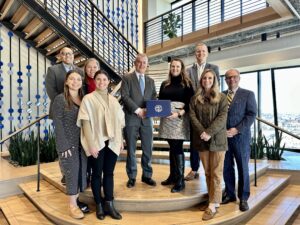Welcome to Southern States Bank customers! Visit our FAQ page to learn more about your transition to FirstBank. Learn More >
FirstBank Joins USDF Consortium™ as Founding Member in Launch to Enable Banks to Mint USDF Stablecoins
NEWS PROVIDED BY USDF Consortium
SAN FRANCISCO, Jan. 12, 2022 /PRNewswire/ — The USDF Consortium™ (the Consortium), an association of FDIC-insured financial institutions, launched today with a mission to build a network of banks to further the adoption and interoperability of a bank-minted stablecoin (USDF™), which will facilitate the compliant transfer of value on the blockchain, removing friction in the financial system and unlocking the financial opportunities that blockchain and digital transactions can provide to a greater network of users.
The Consortium’s founding bank members include New York Community Bank (NYCB), NBH Bank, FirstBank, Sterling National Bank, and Synovus Bank. Figure Technologies, Inc. and JAM FINTOP are also founding members and will facilitate and promote the adoption of USDF. The Consortium looks to significantly grow its membership of FDIC-insured banks through 2022 and beyond.
USDF is a bank-minted alternative to non-bank-issued stablecoins. USDF will be minted exclusively by U.S. banks and will be redeemable on a 1:1 basis for cash from a Consortium member bank. USDF addresses the consumer protection and regulatory concerns of non-bank issued stablecoins and offers a more secure option for transacting on blockchain.
USDF operates on the public Provenance Blockchain. The availability of USDF on a public blockchain means that, in addition to peer-to-peer and business-to-business money transfers, banks and their customers will be able to use USDF for a wide range of applications, including capital call financing as well as invoice and supply chain finance.
“USDF opens up endless possibilities for the expanding world of DeFi transactions,” said Figure CEO Mike Cagney. “The ease and immediacy of using USDF for on-chain transactions was demonstrated this fall when NYCB minted USDF used to settle securities trades executed on Figure’s alternative trading systems. We are tremendously excited that NYCB expects to be minting USDF on demand and on a regular basis in the coming weeks.”
The Consortium was formed to meet the needs of customers demanding more access to blockchain applications for payments and other transactions. “This will solve a critical need to move funds on blockchain, and it does so in a way that can scale, adheres to regulatory standards, and is acceptable to all users from large institutional investors to retail customers,” said Andrew Kaplan, NYCB’s Chief Digital and Banking as a Service Officer. “As a form of digital currency created and administered by regulated U.S. banks within the USDF Consortium, USDF will enable wide use of an on-chain, real time payments system that satisfies important principles of safety and soundness, compliance with anti-money laundering standards, and financial stability.”
“The USDF Consortium will allow banks of all sizes, and importantly, community banks, to provide the digital banking solutions that more and more of our clients expect,” said Valerie Kramer, NBH Bank’s Chief Digital Officer. “This aligns with our focus on building out a comprehensive digital financial ecosystem to provide greater access to credit, FDIC-insured depository and treasury management solutions, and integrated financial information, all while lowering transaction costs for small and medium-sized businesses.”
“Our membership in the Consortium will enable us to integrate real-time payments into our operating model, allowing us to leverage the benefits of blockchain technology to streamline multi-party decisioning processes and provide certainty of settlement. We are exploring specific segment-focused use cases that are relevant to our commercial model, including potential applications to commercial lending and loan syndications,” said Bea Ordonez, Chief Financial Officer of Sterling National Bank.
The USDF Consortium is doing the foundational work to allow banks to leverage the breakthrough technology of blockchain for responsible innovation and growth.
The Consortium’s founding bank members and Figure have a representative on the Board of Directors of the Consortium, which will manage the governance, activities, membership, and other aspects of the Consortium. Interested banks can visit www.usdfconsortium.com to learn more about the Consortium, USDF, and membership requirements, and to apply to become a member.
ABOUT USDF CONSORTIUM
The USDF Consortium™ is a membership-based association and is not an FDIC-insured bank. We are working to coordinate the efforts of banks in minting USDF in a regulatory compliant manner; build out the bank network; and ensure interoperability of USDF to realize the full potential of blockchain technology to better serve consumers. The USDF Consortium is making the market safer, cheaper, and more reliable for consumers who want to transact on blockchain by ensuring banks continue to play an important role in the financial ecosystem as blockchain adoption proliferates. We are committed to building the foundation and advancing responsible innovation that will allow banks to harness this technology. To learn more, and for a full list of the founding member companies, please visit the Consortium’s website at www.usdfconsortium.com.
CAUTIONARY STATEMENTS REGARDING FORWARD-LOOKING INFORMATION:
Certain statements in this press release may constitute “forward-looking statements” within the meaning of the Private Securities Litigation Reform Act of 1995, Section 27A of the Securities Act of 1933, as amended, and Section 21E of the Securities Exchange Act of 1934, as amended, with respect to any of the following concerning the USDF Consortium, Figure, JAM FINTOP, and/or any of the referenced Banks or respective bank holding companies (each a “Referenced Entity”): the Referenced Entity’s beliefs, goals, intentions, and expectations, including those regarding revenues, earnings, strategic relationships, acquisitions, USDF minting, and membership; the Referenced Entity’s estimates of future costs and benefits of the actions the Referenced Entity may take; and the Referenced Entity’s ability to achieve its financial and other strategic goals, or expected synergies and operating efficiencies in, or as a result of, the subject of the forward-looking statement within expected timeframes or at all. These forward-looking statements also include, without limitation, those relating to the terms, timing and closing of any pending or proposed material transaction or initiative undertaken by the Referenced Entity (each a “transaction”). Forward-looking statements are typically identified by such words as “believe,” “expect,” “anticipate,” “intend,” “outlook,” “estimate,” “forecast,” “project,” “should,” and other similar words and expressions, and are subject to numerous assumptions, risks, and uncertainties, which change over time.
Additionally, forward-looking statements speak only as of the date they are made and none of the Referenced Entities assumes any duty, and does not undertake, to update such forward-looking statements. Furthermore, because forward-looking statements are subject to assumptions and uncertainties, actual results or future events could differ, possibly materially, from those indicated in such forward-looking statements as a result of a variety of factors, many of which are beyond the control of the Referenced Entity. Factors that could cause actual results to differ materially include the following: the occurrence of any event, change or other circumstances that could give rise to the right of any party to terminate a transaction; the outcome of any legal proceedings that may be instituted against a Referenced Entity, including those with respect to a transaction; the possibility that the subject of the forward-looking statement, will not occur when expected or at all because required regulatory or other approvals are not received or other conditions to the occurrence are not satisfied on a timely basis or at all, or are obtained subject to conditions that are not anticipated; the possibility that the anticipated benefits of the subject of the forward-looking statement will not be realized when expected or at all; and the other factors discussed in the “Risk Factors” section of a Referenced Entity’s latest Annual Report on Form 10-K and in the “Risk Factors” section in a Referenced Entity’s subsequent Quarterly Reports on Form 10-Q , and in other reports the Referenced Entity files with the U.S. Securities and Exchange Commission (the “SEC”), which are available at http://www.sec.gov and in the applicable SEC filings section of the Referenced Entity’s website.
Media Contact:
Bill McQuillen
bill@usdfconsortium.com
202.320.2590
SOURCE USDF Consortium

FirstBank has helped customers build momentum for over a century, with more access, answers and the latest products and services. Click on the link below to learn more about how our local banking model helps fuel your future. We keep going strong by banking on your strengths to help our communities go far.
7 am – 4 pm CST Saturday Call 1-800-413-4211






